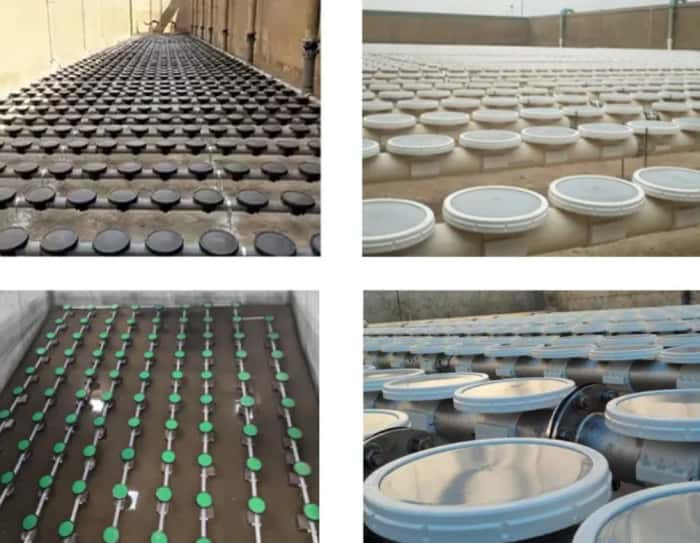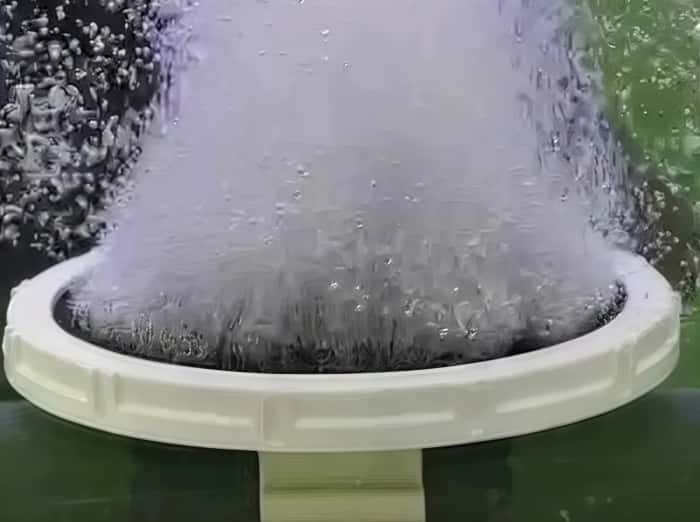In wastewater treatment, both primary and secondary stages often use aeration to eliminate organic matter. Submerged bubble aeration, in particular, is highly effective as it disperses fine air bubbles that mix with the wastewater, stimulating aerobic bacteria to break down organic pollutants. Generally, submerged bubble aeration is considered a more advanced method compared to surface aeration, which is why many wastewater treatment plants have adopted this approach.
Two popular types of submerged aeration systems are fine bubble diffusers and coarse bubble diffusers. Although both types work through aeration, they differ significantly in design, function, and the type of bubbles they produce. Understanding the differences between fine and coarse bubble diffusers can help facilities choose the most suitable system for their specific needs.
Fine Bubble Diffusers
Fine bubble diffusers and coarse bubble diffusers are both common submerged aeration methods in wastewater treatment, where the diffusion of bubbles promotes the aerobic bacteria to decompose organic matter. Compared to surface aeration, this method is more efficient and environmentally friendly.
Fine bubble diffusers produce small bubbles with diameters of approximately 1–3 millimeters, and the standard oxygen transfer efficiency (SOTE) can reach over 2%. Coarse bubble diffusers, on the other hand, generate larger bubbles, with the SOTE typically below 1%.

Types of Fine Bubble Diffusers
Fine bubble diffusers come in different designs, each suited for specific wastewater treatment applications:
- Disk Diffusers: These consist of an EPDM rubber membrane mounted on a plate. When compressed air flows through the membrane, it expands, releasing thousands of small bubbles into the water.
- Tube Diffusers: These diffusers are long, narrow cylinders made of plastic or ceramic, surrounded by an EPDM rubber membrane. The membrane expands to release small bubbles. Tube diffusers tend to have a larger surface area and produce more bubbles compared to disk diffusers.
- Perforated Pipe Diffusers: These diffusers consist of perforated plastic tubes. Instead of expanding and contracting material, compressed air escapes through the perforations.
Advantages of Fine Bubble Diffusers
- Efficient Aeration: Fine bubble diffusers are known for their high oxygen transfer efficiency, with fine bubbles dispersing significantly more oxygen into the water compared to coarse bubbles. This makes them ideal for secondary treatment processes where high levels of organic waste removal are required.
- Improved Oxygen Transfer Efficiency: Fine bubbles provide a larger surface area for oxygen transfer, enabling greater contact time between air and water. The smaller size and slower rise of the bubbles allow more oxygen to dissolve into the water.
- Energy Efficiency: Fine bubble diffusers are energy-efficient because they require less compressed air to achieve the same oxygen transfer as coarse bubble systems, resulting in reduced blower demands and lower operating costs.
Disadvantages of Fine Bubble Diffusers
- Lower Alpha Factor: The small pores are easily blocked by organic matter, leading to reduced efficiency and increased backpressure.
- Weak Mixing Ability: Small bubbles cannot generate enough flow to keep solids suspended.
- Complex Installation and Cleaning: Cleaning often requires emptying the tank, which is time-consuming and labor-intensive.
Coarse Bubble Diffusers
Coarse bubble diffusers are commonly used in large treatment basins, generating bubbles with diameters ranging from 3 to 50 millimeters. These diffusers operate at lower pressures and are typically made from materials like PVC or EPDM rubber.
Although coarse bubble diffusers have lower oxygen transfer efficiency, they are less prone to clogging and fouling.

Advantages of Coarse Bubble Diffusers
- High Alpha Factor: Coarse bubble diffusers have larger openings, which makes them less prone to fouling and clogging. This results in fewer maintenance requirements compared to fine bubble diffusers.
- Strong Mixing: The larger bubbles provide greater mixing power, helping to keep biosolids suspended and aiding in the breakdown of organic waste. The mixing helps to prevent unwanted sludge formation.
- Low Maintenance: Due to the larger pores, coarse bubble diffusers are less likely to clog, reducing the need for frequent cleaning and maintenance, which leads to cost savings in the long term.
- Durability: Coarse bubble diffusers tend to last longer due to their resistance to fouling, requiring less frequent replacement.
Disadvantages of Coarse Bubble Diffusers
- Low Oxygen Transfer Efficiency: Large bubbles rise quickly and have a shorter contact time with water, resulting in lower oxygen utilization.
- Poor Aeration Efficiency: The amount of oxygen released per unit of energy consumed is lower.
- High Energy Consumption: The blower requires higher pressure, leading to greater power consumption.
Which is Better: Fine Bubble Diffuser or Coarse Bubble Diffuser?
The choice between fine and coarse bubble diffusers depends on the specific needs of the wastewater treatment plant. Fine bubble diffusers offer superior oxygen transfer efficiency, better energy savings, and more effective aeration, making them the preferred choice for applications that require high levels of organic matter removal, such as secondary treatment.
On the other hand, coarse bubble diffusers are ideal for applications requiring strong mixing and those where maintenance costs need to be minimized. They are also beneficial for situations where long-term durability and resistance to fouling are crucial.
| Project | Fine Bubble Diffuser | Coarse Bubble Diffuser |
|---|---|---|
| Oxygen Transfer Efficiency | High | Low |
| Energy Consumption | Low | High |
| Installation & Maintenance | Simple, easy to clean | Requires shutdown and draining for maintenance |
| Anti-Clogging Ability | Prone to clogging | Not prone to clogging |
| Mixing Effect | Moderate | Strong |
| Suitable Application | Secondary treatment, energy-saving needs | Primary treatment, strong mixing needs |
Overall, if the wastewater treatment system aims for efficient organic matter removal and energy savings, fine bubble diffusers are undoubtedly the better choice. However, if the system places more emphasis on anti-fouling durability and mixing capability, such as in primary treatment or in basins with high solid concentrations, coarse bubble diffusers still have their advantages.
Conclusion
In conclusion, both fine bubble diffusers and coarse bubble diffusers play important roles in wastewater treatment. Fine bubble diffusers are more efficient for oxygen transfer and energy savings, while coarse bubble diffusers excel at mixing and durability. The best choice for a facility will depend on its treatment requirements, maintenance capabilities, and energy considerations.
